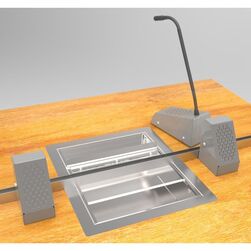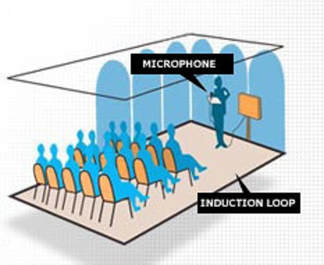Accessible Hearing Solutions provides system installations that are used to improve accessibility for businesses, non-profits, public sector, municipalities, educational institutions, and community groups such as banks, pharmacies, libraries, airports, recreation centres, hospitals, nursing homes, health care clinics, and universities that value reducing barriers for people living with hearing loss (which represent approximately one in five people in the general population).
Receiving services can be challenging for people who are Hard of Hearing because:
- background noise often "masks" the desired signal (e.g., background music, sound of other conversations).
- of increased distance between the listener and speaker (e.g., sitting in the back row in a house of worship or conference) reduces the volume of the speaker.
- of room acoustics (e.g., reverberation, unwanted machine noise) often distorts the quality of sound.
- the face of the speaker may be obstructed from view due to distance, seating position, talking behind glass partition which may reduce facial cues or lip-reading ability.
- the volume of the speaker may be lowered due to privacy concerns (e.g., softer voice may make it harder to hear in a pharmacy, library, or bank when discussing private matters).
- poor lighting (e.g., dark rooms or having a conversation in front of a bright window) may make getting information from facial cues or lip reading more challenging).
- employees or front-line service providers may not be communicating effectively with a person who is Hard of Hearing. Important behaviors include getting the attention of the person first, facing the person, speaking at a reasonable speed, repeating and re-phrasing when necessary, speaking loudly but not shouting, and having effective communication as a goal.
| |||||||
Loop Systems (or Induction Loop Systems)
Loop systems allow someone who wears hearing aid(s) or a cochlear implant to connect directly to what is being said into a microphone. This greatly reduces the barriers caused by background noise, distance, and poor room acoustics. Having the signal go directly into someone's hearing aid(s) or cochlear implant is advantageous because these devices would be set for their exact hearing loss. Loop systems support a universal design approach by using an international symbol that a hearing loop is available so people do not need to ask for help or borrow another device. They simply need to switch their hearing aid or cochlear implant to "T" for telecoil and they immediately have greater access to hearing. Telecoils are found in the majority of hearing aids sold.
For a first hand account, read this article in the New York Times http://www.nytimes.com/2011/10/24/science/24loops.html
Loop systems allow someone who wears hearing aid(s) or a cochlear implant to connect directly to what is being said into a microphone. This greatly reduces the barriers caused by background noise, distance, and poor room acoustics. Having the signal go directly into someone's hearing aid(s) or cochlear implant is advantageous because these devices would be set for their exact hearing loss. Loop systems support a universal design approach by using an international symbol that a hearing loop is available so people do not need to ask for help or borrow another device. They simply need to switch their hearing aid or cochlear implant to "T" for telecoil and they immediately have greater access to hearing. Telecoils are found in the majority of hearing aids sold.
For a first hand account, read this article in the New York Times http://www.nytimes.com/2011/10/24/science/24loops.html

Speech Transfer System with a Counter Loop
Counter loop systems are specifically created to reduce barriers during counter service. It has a microphone to capture the spoken word, an induction loop amplifier to process the audio signal, and a loop cable covering a specific area to act as an aerial to create a magnetic signal. When a hearing aid user selects the ‘T’ setting (telecoil) on their hearing instrument (which is a small copper coil), they can pick up sounds directly from the loop system through this magnetic signal improving clarity since it reduces background noise and minimizes the effects of poor room acoustics.
Speech Transfer Systems have a microphone and speaker on both sides of plexiglass improving accessibility and reducing listening effort for everyone, especially those with hearing loss without hearing aids.
Counter loop systems are specifically created to reduce barriers during counter service. It has a microphone to capture the spoken word, an induction loop amplifier to process the audio signal, and a loop cable covering a specific area to act as an aerial to create a magnetic signal. When a hearing aid user selects the ‘T’ setting (telecoil) on their hearing instrument (which is a small copper coil), they can pick up sounds directly from the loop system through this magnetic signal improving clarity since it reduces background noise and minimizes the effects of poor room acoustics.
Speech Transfer Systems have a microphone and speaker on both sides of plexiglass improving accessibility and reducing listening effort for everyone, especially those with hearing loss without hearing aids.

Room loops
Room loop systems are designed to provide hearing loop facilities over a much wider area such as meeting rooms, places of worship, auditoriums, lecture halls, school rooms, group television watching in nursing homes, and entertainment venues. It is important to note there are many different loop designs and the selection process is a very important part of ensuring the correct loop system is chosen. How the room is used, room area and the construction of the building are all factors which need to be considered in ensuring the correct solution is chosen. Hearing loop solutions for rooms can include a basic perimeter loop to a low-spill phased array system that substantially reduces the amount of magnetic field that can ‘spill over’ into the space served by other loops.
Room loop systems are designed to provide hearing loop facilities over a much wider area such as meeting rooms, places of worship, auditoriums, lecture halls, school rooms, group television watching in nursing homes, and entertainment venues. It is important to note there are many different loop designs and the selection process is a very important part of ensuring the correct loop system is chosen. How the room is used, room area and the construction of the building are all factors which need to be considered in ensuring the correct solution is chosen. Hearing loop solutions for rooms can include a basic perimeter loop to a low-spill phased array system that substantially reduces the amount of magnetic field that can ‘spill over’ into the space served by other loops.
|
|
|
|
|
|
|
|
Advantages of Loop Systems
- It is universal so any T-coil equipped hearing aid or cochlear implant (regardless of the make or model) can use the system worldwide.
- There is essentially no limit to the number of users of the system.
- Users benefit from the loop technology with their own hearing aids which are customized for their own degree of hearing loss.
- Improved clarity benefits businesses and individuals by enhancing customer service, understanding, and decreases listening effort opening up new revenue streams.
- A loop system has a reasonable cost to install with minimal or no maintenance.
- Optimizes opportunities for people to receive help without extra steps or asking for help.
- Separate portable receivers and headsets can be purchased by organizations for those that do not have access to hearing aids. Accessible Hearing Solutions can provide information on infection control procedures.
- Unlike Bluetooth technology that requires significant battery power and has limited range, loop systems are capable of covering a wide area with little battery drain.
- All installations should meet the requirements of IEC 60118-4. Compliance must be considered during specification, design, installation and maintenance of the system. Accessible Hearing Solutions is trained to install loop systems and will provide documentation to ensure measurements fulfill all standards and compliance requirements.
- Compliance with accessibility laws (see our section on accessibility laws for more information).
How can we help?
Accessible Hearing Solutions provides practical, hands-on educational content and technological services: solutions that help remove barriers to enhance communication for everyone and provide compliance with accessibility laws.
Providing accessible services can improve an organization's image over a competitor's, encourages customer loyalty, increases brand awareness, and generates positive publicity.
Accessible Hearing Solutions will provide:
Accessible Hearing Solutions provides practical, hands-on educational content and technological services: solutions that help remove barriers to enhance communication for everyone and provide compliance with accessibility laws.
Providing accessible services can improve an organization's image over a competitor's, encourages customer loyalty, increases brand awareness, and generates positive publicity.
Accessible Hearing Solutions will provide:
- Custom loop-system design and installation to ensure you get the right product for your venue which will comply with international standards (IEC 60118-4).
- Signage to inform that a Hearing Loop is installed.
- Educational training to educate staff on how to operate and perform listening checks of installed equipment.
- Publish-ready announcements for your newsletter, house of worship bulletin or e-mails.
- Advertising on our website and Facebook page informing the public your location is accessible for people who are Hard of Hearing.
- Plaques to commemorate the generosity of any donor(s) can be available upon request.
More Information:
| |||||||
| |||||||
| |||||||||||||
For a site assessment or to find out if an existing system is working optimally, please contact us at: info@accessyourhearing.com
